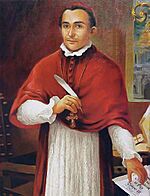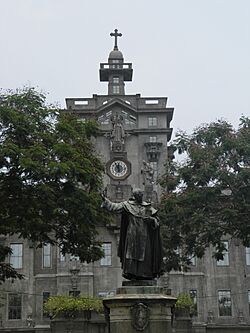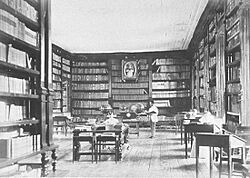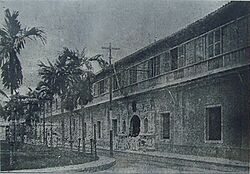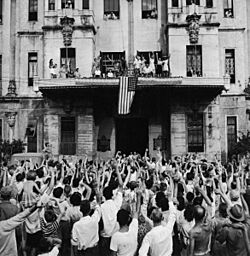History of the University of Santo Tomas facts for kids
The University of Santo Tomas (UST) is one of the oldest universities in the Philippines and in Asia. It was started on April 28, 1611, by Miguel de Benavides, who was the third Archbishop of Manila. He wanted to create a school to train young men to become priests.
The school was first located in Intramuros, a walled city in Manila. It was initially called Colegio de Nuestra Señora del Santísimo Rosario. Later, it was renamed Colegio de Santo Tomás to honor Saint Thomas Aquinas, a famous Dominican thinker. In 1624, the school was allowed to give out college degrees in subjects like religion, philosophy, and arts.
On November 20, 1645, Pope Innocent X officially made the college a university. Later, in 1680, the King of Spain supported it. Over the years, UST earned special titles: "Royal," "Pontifical," and "The Catholic University of the Philippines."
In 1785, King Charles III of Spain called it a "Royal University." This was because the students and staff helped defend Manila during a British invasion. In 1902, Pope Leo XIII named it a "Pontifical University." Then, in 1947, Pope Pius XII gave it the title "The Catholic University of the Philippines." So, its full name today is Pontifical and Royal University of Santo Tomas, Manila.
As more students joined, the university moved in 1927 to its current location in Sampaloc, Manila. This new campus covers a large area of 21.5 hectares. Since it was founded, the university's classes have only stopped twice. Once was from 1898 to 1899 during the Philippine revolution against Spain. The second time was from 1942 to 1945, when the Japanese military used the campus as a camp for prisoners during the Japanese occupation of Manila.
Contents
Who Started the University?
Many Dominican missionaries helped start the university. These included Miguel de Benavides, Bernardo Navarro, and other experienced professors. However, Miguel de Benavides is mainly known as the founder. He was the first to donate money to keep the school running.
Miguel de Benavides was born in 1550 in Spain. He was a deep thinker and believed in helping people. He became the first Bishop of Nueva Segovia (now Vigan) in the Philippines. He also wrote the Doctrina Christiana in Chinese. This was the first book ever printed in the Philippines.
Later, he became the third Archbishop of Manila in 1602. He passed away on July 26, 1605. Before he died, he convinced King Philip II to let the people of the Philippines decide if they wanted to be under the King's protection. This vote happened in 1599 and was the only one of its kind before the 20th century.
In 1878, the university's head wanted to build a statue of the founder. This statue was made in Paris in 1889. Money for it came from teachers, students, and friends of the university. It was officially revealed on July 2, 1891, at the start of the school year.
The original statue was a bronze figure of Benavides on a stone base. It faced the old campus in Intramuros. During the 1945 Battle of Manila, a bomb hit the statue, destroying its base. It was put back up on November 13, 1946, inside the current UST campus in Sampaloc, Manila.
Today, the bronze statue of Benavides stands in front of the Main Building. It is on a granite base with four lions. Each lion holds a coat of arms from the Philippines, Spain, the Holy See, and the Dominican Order. Benavides is shown wearing the simple clothes of a Dominican missionary. His right hand points to the sky, and his left hand holds a book. He wears a skull cap and a cross, showing he was a Bishop.
How the University Started
The university likely grew from the Dominican school of Santo Domingo. The Dominican Order arrived in the Philippines in 1587. The first Bishop of the Philippines, Domingo de Salazar, wanted to create a college like those in Mexico. He wanted a place where religious and non-religious people could study. So, a "School of Grammar" was set up.
Miguel de Benavides left his library and goods worth ₱1,500 in his will when he died in 1605. This money became the first funds for the new school. Other people also donated, increasing the funds to ₱7,140. Even with little money, Benavides' friends continued his dream.
In 1609, they asked King Philip III for permission to open the college. This permission reached Manila in 1611. On April 28, 1611, the official document to start the school was signed. Thirty-four years later, this school became a university.
Bernardo de Santa Catalina helped make sure Benavides' wishes were carried out. He found a building near the Dominican church in Intramuros for the college. Historians say the university grew from the early teaching efforts of the Dominican Order after they arrived in 1587.
Quick facts for kids Name changes |
|
|---|---|
| 1611: | Colegio de Nuestra Señora del Santísimo Rosario |
| 1616: | Colegio de Santo Tomás de Nuestra Señora del Santísimo Rosario |
| 1617: | Colegio de Santo Tomás de Manila |
| 1619: | Colegio de Santo Tomás de Aquino |
| 1645: | Universidad de Santo Tomás |
| 1785: | Given the title of "Real" (Spanish for "Royal") |
| 1870: | Universidad de Filipinas |
| 1877: | Universidad de Santo Tomas |
| 1902: | Given the title of "Pontifical" |
| 1947: | Given the title of "Catholic University of the Philippines" |
| Present: | Pontifical and Royal University of Santo Tomas, Manila |
Early Years of Learning
The school began by offering courses in religion, arts, and philosophy. It was first known as the College of Our Lady of the Most Holy Rosary. In 1617, it was renamed the College of Santo Tomas after St. Thomas Aquinas.
Classes officially started in 1612. The Dominican Order took responsibility for running the school. In 1619, King Philip IV of Spain approved the college. The Holy See (the Pope's authority) also recognized the new college in 1619. In 1627, Pope Urban VIII allowed the college to give out academic degrees. This meant the degrees had both royal and papal approval.
On November 20, 1645, Pope Innocent X changed the college into a university. This was done through his official letter, In Supreminenti. This gave UST the status of a university under the Pope's protection. Later, on May 12, 1680, King Charles II of Spain also gave royal support to the university.
In 1645, the head of the Dominican Order was given the power to choose the university's rector (the highest leader). The rector was in charge of the university's studies and rules. In 1732, the university started offering a course in Canon Law (Church law).
The Campus in Intramuros
The first campus was located inside the walled city of Intramuros. It was across from the old Santo Domingo Church. The building had two floors and covered a large area.
Old maps show two main courtyards. The upper courtyard was once a graveyard before becoming a plaza. This is where the first Benavides monument stood in 1891. The lower courtyard was the main campus area. It also had the Puerta del Colegio, which was the main entrance. This gate later became the famous Arch of the Centuries.
Maps from the 1870s show that the campus had an assembly hall, a library, a physics lab, and a natural history museum. The university tried to expand within Intramuros. In 1896, it bought land across the main campus. However, these plans stopped because of the Philippine Revolution.
During the Battle of Manila in 1945, the Intramuros campus was destroyed. The land was later sold in 1949.
First Students to Graduate
In the early years, only a few students graduated because not many enrolled. In 1619, when the college was founded, there were only 12 students living there. Records of early graduations only exist from 1663.
A document from 1631 mentions three graduates from 1629: Diego de Sanabria, who became a doctor in theology, and Juan Fernandez and Sebastian Ramos, who both earned master's degrees in arts. Diego de Sanabria is considered the first graduate. He was called el primer parto, meaning the "college's first born."
The Eighteenth Century: Royal Recognition
King Philip IV had given his royal approval in 1623. Official royal support was given to the university by King Charles II in 1680.
However, the title "Royal" (Real) was only given by King Charles III on May 20, 1785. This happened when Domingo Collantes was the rector. The title was a reward for UST's loyalty to the Spanish crown. The university had offered its students to help defend Manila when Spain was at war with England.
The Nineteenth Century: Changes and Challenges
In 1865, a new rule for high school education was made. UST became like a Bureau of Education, with its rector as the director. This meant UST was in charge of all high school matters. This included hiring teachers, checking grades, and signing diplomas for high school graduates.
In 1870, a Spanish minister tried to completely change the Philippine education system. He wanted to put all high schools under one "Instituto Filipino." He also wanted to turn the University of Santo Tomás into a "Universidad de Filipinas." This would have made it the Royal and Pontifical University of the Philippines.
But these plans were stopped when the Spanish government changed. The university was given back to the Dominicans. It was only in 1877 that Spain again recognized the university as being run by a religious order.
The university closed during the Philippine Revolution in 1896 due to the fighting. It reopened for the 1897–1898 school year. But when the Spanish-American War started and the Revolution continued in 1898, classes were stopped again. UST remained closed for the 1898–1899 school year.
José Rizal's Time at UST
José Rizal started at the university in 1877. He first studied a pre-law course, which included philosophy. He earned top grades in this course.
Later, he decided to study medicine. In 1878–1879, he took both the pre-medicine course and the first year of Medicine at the same time. This was against the rules, but Rizal was given special permission. The pre-medicine course was an advanced study of subjects like physics, chemistry, and natural history.
While studying medicine, Rizal's grades were good, but not as high as his grades in arts and letters. This was also true for his studies in Madrid. Rizal never complained about his grades at UST, but he did complain about his grades in Madrid.
In his fourth and final year at the university, only seven students remained, and Rizal was one of them. He finished that year in second place.
The Twentieth Century: Growth and War
After the Philippine Revolution, Spanish members of the Dominican Order left the Philippines in 1899. American friars then took over some churches and schools.
In 1906, the university officially became a corporation. Its name was "Royal and Pontifical University of Santo Tomas," or "University of Santo Tomas" for short. Its main office was in Intramuros.
In the early 1900s, Francesca Bustamante Bayot donated a large piece of land (21.5 hectares) in Sampaloc, Manila, to the Dominicans. This allowed the university to expand outside Intramuros. In 1927, the Main Building was opened at the new Sampaloc site. It was the first earthquake-proof building in the Philippines. Most departments moved there, but Medicine, Surgery, and Civil Law stayed in Intramuros for a while.
For the first time, women were allowed to enroll in the Faculty of Pharmacy in the 1924–1925 school year. UST was one of the first universities in the Philippines to allow both men and women to study together. In that year, 24 women enrolled in Pharmacy. The university had already been giving midwifery certificates to women since 1879. More departments opened to women later, like Education in 1926 and Medicine in 1932. Eventually, only the religious studies faculties remained for men only.
In 1925, UST became one of the first universities in the Philippines to require English as the main language for teaching, replacing Spanish. In 1971, Leonardo Z. Legazpi became the first Filipino Rector (head) of UST.
As mentioned, the university's academic life was only stopped twice in its long history: during the Philippine Revolution and the Japanese occupation. Over 90 Rectors have led UST.
Many important people have visited the university. These include Pope Paul VI in 1970, King Juan Carlos I of Spain in 1974 and 1995, Mother Teresa in 1977 and 1984, and Pope John Paul II in 1981 and 1995.
Becoming a Pontifical University
On September 17, 1902, Pope Leo XIII officially gave the university the title of "Pontifical University." This title showed the Pope's special honor and protection for UST.
UST is the only remaining Pontifical university in Asia. The Vatican's official directory lists it as one of only 24 Pontifical universities in the world. Most of these are in Rome or Latin America. UST is the second oldest university to be declared Pontifical by the Pope, after the Gregorian University in Rome.
300th Anniversary Celebration
From December 16 to 20, 1911, the university celebrated its 300th anniversary. The events included a special mass for Miguel de Benavides, the unveiling of a plaque, and the laying of the foundation stone for the future building in Sampaloc. There was also a big dinner with about 300 guests, including leaders and alumni. The latest graduates received their degrees in the old Santo Domingo Church. Both Pope Pius X and Philippine church leaders sent congratulatory messages.
World War II and the Internment Camp
During World War II, the Japanese military turned the UST campus into an internment camp. This camp held civilians, foreigners, and prisoners of war.
Soon after Japanese forces entered Manila in January 1942, many Americans and other Allied citizens were brought to the university camp. The camp held 3,259 people. Most were American, but there were also British, Dutch, Polish, Mexican, and Nicaraguan citizens.
All university buildings, except the seminary, printing press, and two floors of the Main Building, were used by the Japanese. The prisoners stayed in the Main Building, the Education Building (now UST Hospital), and other smaller buildings. The Japanese tried to stop communication between the prisoners and the outside world.
The university authorities worked with the prisoners and Japanese officials. Dominican priests were still allowed to manage the use of university buildings and equipment, but the Japanese had the final say.
During the liberation of Manila in 1945, the university buildings in Intramuros were destroyed. The Japanese burned them on February 8, 1944. The buildings in Sampaloc were not destroyed but had some minor damage from shelling.
About 335 prisoners were hurt, with 35 dying and 300 wounded. Some were buried outside the campus, and others inside. Luckily, the UST printing press, the first in the country, was moved from Intramuros to the Sampaloc campus in 1940, just before the war started.
Becoming the Catholic University of the Philippines
On April 30, 1947, Pope Pius XII gave UST the title "The Catholic University of the Philippines." In terms of student numbers, UST is the largest Catholic university in the world located on one campus.
350th Anniversary Celebration
Pope John XXIII sent a warm letter to the university. He called UST the "most shining light of Christian Wisdom." He congratulated the university on its 350th year and wished it continued growth and peace. He also praised the university for being a "strong supporter of Christian civilization." The university celebrated its 350th year throughout 1961. The main events, like the alumni dinner and a concert, were held in March 1961.
Filipino Leadership in the University
| Filipino Rectors | |
|---|---|
| Name | Years of Rectorship |
|
|
|
| Leonard Legaspi | 1971–1977 |
| Norberto Castillo | 1982–1990 |
| Rolando de la Rosa | 1990–1998 |
| Tamerlane R. Lana | 1998–2006 |
| Ernesto M. Arceo | 2006–2007 |
| Rolando de la Rosa | 2008–2012 |
| Herminio Dagohoy | 2012–2020 |
| Richard Ang | 2020–present |
A movement to have more Filipino leaders in the Dominican Order in the Philippines began in 1951. Filipino Dominicans wanted to hold important positions in UST. Students also held protests, asking for Spanish Dominicans to be removed from leadership roles.
This movement reached its goal when Leonard Legaspi became the first Filipino rector of the university in 1971. He also made sure that the titles on all diplomas were translated into Filipino.
The movement for Filipino leadership in the university was part of a larger effort to have more Filipinos in charge across the country. This was achieved when the Dominican Province of the Philippines was created on December 8, 1971.
Modern History of UST
As of 2013, UST had about 45,000 students. This included 33,000 undergraduate students and 5,000 students in medicine, law, and graduate programs. Each year, the university accepts about 8,500 new students from 50,000 applicants.
After 400 years, the university has five main areas of study: Science and Technology, Arts and Humanities, Education and Social Sciences, Medicine and Health, and Religious Studies. These are spread across 21 different faculties, colleges, and institutes.
400th Anniversary Celebration
The university celebrated its 400th anniversary in 2011. Plans for this event included new academic programs and improvements to the university's buildings. These efforts aimed to make UST more famous nationally and internationally.
New campuses are being planned in Santa Rosa, Laguna, and General Santos City.
Improvements are ongoing at the Sampaloc campus. The Plaza Mayor in front of the Main Building and the Quadricentennial Square were built in 2006. The Quadricentennial Square includes a sculpture, a fountain, and an alumni walkway. The UST Tan Yan Kee Student Center was built to provide more space for student activities. The Main Building, which is over 80 years old, and the artworks in the UST Museum are now protected under a special preservation program.
The UST Benavides Cancer Institute was also established in 2006. This was part of a plan to redevelop and expand the UST Hospital for its 60th anniversary and the 400th anniversary.
Another big project was building a new, modern, four-story gymnasium. It cost P800 million and can seat 5,792 people. It was finished in time for the 400th anniversary. The Thomasian Alumni Center, a 10-story building, is also being built. It will celebrate the achievements of UST alumni worldwide.
The UST Publishing House started a project in 2001 called "400 Books at 400!". They aim to publish 400 books by the 400th anniversary. These books cover many subjects, from religion to literature and medicine.
Student Voice and Rules
Since the late 2010s, some students have said that the university has too many rules and limits their freedom of expression.
The official UST student handbook says students cannot join or create "unrecognized organizations" that have "illegal or immoral purposes." It also prohibits "unauthorized student activity." Because of these rules, some students have been suspended or expelled. For example, in 2018, some Senior High School students who protested against a school program were put on probation. In 2020, a student was expelled for being part of a group that called for "academic ease."
In August 2020, the university's Office of Student Affairs (OSA) said that student groups needed permission to post anything on social media. They also had to give their advisers full access to their social media accounts. Student leaders criticized this, saying it limited their freedom of expression.
During the 2023 student council elections, the student newspaper, The Varsitarian, wrote that fewer students were participating in elections. It said this was due to old rules and alleged "tough tactics" by the Office of Student Affairs against student leaders who spoke up.
TomasinoWeb and the 7-Eleven Incident
In February 2024, the OSA told a student organization called TomasinoWeb to remove a photo they posted. The photo showed students from the College of Information and Computing Sciences (CISC) entering a 7-Eleven store. The university said the photo made CISC students look bad because their uniform looked like the 7-Eleven employee uniform. TomasinoWeb was also warned that they might not be recognized as an official student group. After this, the adviser for TomasinoWeb resigned because of the censorship.
Many groups inside and outside UST said this was an "attack on press freedom." Hundreds of UST alumni signed a petition asking the university to change its "strict and outdated policies." The university's Office of Public Affairs said they are working to solve the issue. TomasinoWeb started operating again in March 2024 with a new adviser.
In March 2024, the OSA announced that its director was on sick leave. A new officer is now in charge of talking with student groups and reviewing student policies.
An editorial in The Flame, another student newspaper, said the TomasinoWeb incident caused a lot of unhappiness in the UST community. The issue even gained attention in Congress.
In March 2024, a representative filed a resolution asking the House of Representatives to investigate the alleged censorship and threats by the UST Office for Student Affairs. The resolution aims to address these issues and support academic and campus press freedom for students.
Spanish Royal Support
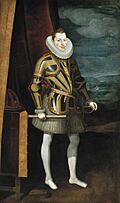
The kings of Spain gave many benefits and special rights to UST. It started in 1609 when King Philip III asked for a report on the planned college. He also asked Pope Paul V to allow the college to teach Philosophy and Theology. These subjects were officially taught by order of King Philip IV in 1624. Three years later, King Philip IV asked Rome to extend these teaching rights for another ten years. He was also the king who asked the Pope to make the college a university in 1645.

King Charles II, in 1680, added to these benefits. He officially declared that the university would be under his royal protection.
Another order from King Charles II, along with two from his successor King Philip V, led to the creation of the Faculties of Civil Law and Canon Law in 1733. At the same time, the Holy See allowed the university to give out degrees in these subjects and others that might be added later.
In 1781, King Charles III allowed the university to create its own rules. Before this, it followed the rules of the University of Mexico.
When Manila was briefly taken over by the British in 1762, the rector of the university, Fr. Domingo Collantes, organized four groups of university students to help defend the city. To thank them for their loyalty, King Charles III, in 1785, expressed his "gratitude and kindness." He renewed his protection and support and gave the university the title of "Very Loyal" and the honors of a "Royal University."
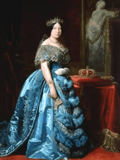
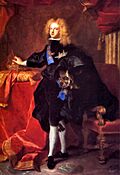
In 1865, Queen Isabel II declared the University of Santo Tomas the main center for public education in the Philippines. All other colleges and schools in the country were connected to it. The rector of the university became the supervisor and inspector of all these schools.
In 1871, the Faculties of Medicine and Pharmacy were created. Three years later, a School for Notaries was also established.
In 1649, the university thanked King Philip IV for his care. They said the university was "a gift of your royal generosity" and asked him to continue his "Royal Solicitude" so it could keep growing.
To show thanks for nearly 300 years of royal kindness, and to keep a connection between Spain and UST, the university gave the title of Royal Patron to King Juan Carlos I of Spain in February 1974.
How Colleges Were Established
The University of Santo Tomas has grown a lot over the centuries. It started with a few basic subjects like theology, philosophy, and arts. Over time, as the needs of the country changed, the university added many new fields of study.
For example, the Faculty of Canon Law (Church law) started in 1733, and the Faculty of Civil Law (regular law) began in 1734. These were among the first law schools in the Philippines. In 1871, the university opened the Faculty of Medicine & Surgery and the Faculty of Pharmacy, which were also the first of their kind in the country.
As the university grew, it added more specialized colleges. The Faculty of Engineering was founded in 1907. The College of Education started in 1926. Architecture was added in 1930, and Commerce and Business Administration in 1934. The Graduate School, for advanced studies, was established in 1938.
After World War II, more colleges were created, such as the Conservatory of Music and the College of Nursing in 1946. In more recent years, the university has continued to expand its offerings. The College of Rehabilitation Sciences was established in 1974, and the College of Fine Arts and Design became a separate college in 2000. Newer additions include the College of Tourism & Hospitality Management in 2009 and the College of Information and Computing Sciences in 2014. The UST Senior High School was also established in 2016.
This growth shows how the university has adapted to provide education in many different areas, from traditional studies to modern fields like technology and hospitality.
|


